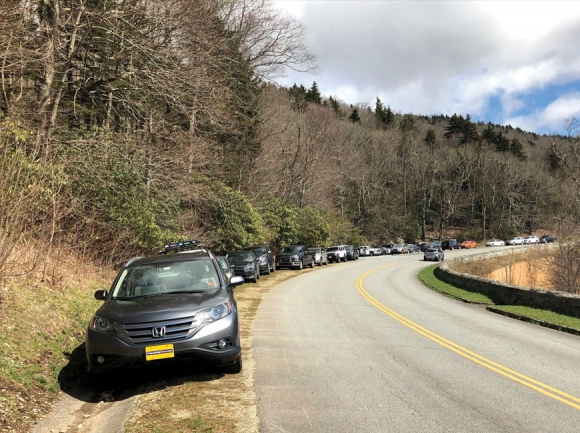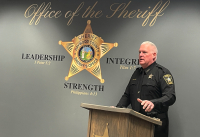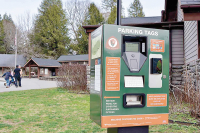Public land managers discuss closure decisions and plans for re-opening
 Vehicles park down the side of the Parkway March 26 as the parking lot for Rough Ridge Trail near Asheville is filled to overflowing. NPS photo
Vehicles park down the side of the Parkway March 26 as the parking lot for Rough Ridge Trail near Asheville is filled to overflowing. NPS photo
While people nationwide are lamenting the loss of bars, restaurants, concerts, festivals and countless other aspects of community life amid the COVID-19 crisis, for many in Western North Carolina the deepest blow has been the loss of access to hundreds of thousands of acres of cherished public lands.
“We live in a very risk-averse society, and each agency is considering its mission in light of the current context,” said Andrew Bobilya, professor and program director for Western Carolina University’s Parks and Recreation Management Program. “I think they’re watching their peers, so to speak, worldwide and trying to make the best decision. But I think to a certain degree they don’t want to be the ones not being seen as supporting the initiative to reduce the spread of the coronavirus or put people in perceived inappropriate situations of risk.”
N.C. State Parks was the first public agency locally to implement closures in response to the virus, on March 16 announcing that park facilities such as visitor centers and campgrounds would close beginning March 17. The Great Smoky Mountains National Park wasn’t far behind, announcing the immediate closure of its visitor centers March 17. Closure of the visitor center in Asheville on March 18 marked the Blue Ridge Parkway’s initial COVID-related change. On March 22, the National Forests in North Carolina closed all front-country campgrounds.
However, land managers did not see these announcements result in decreased visitation or appropriate social distancing.
“What we saw during March was actually increased visitation after other traditional spring break destinations closed, particularly beaches,” said Smokies spokesperson Dana Soehn. “We were actually seeing more people on our crowded trails and along roadways and overlooks.”
Related Items
Reasons to close
The closures accelerated. Currently, the entire GSMNP and all state parks are closed until further notice. The national forests have closed their district ranger offices, and backcountry camping is prohibited in the Pisgah National Forest. A large number of the Pisgah’s popular trails, roads and recreation sites are also closed through Aug. 13, and on April 15 the Parkway issued a ramped-up set of closures that included cessation of vehicle access to the road from the French Broad Overlook just west of Asheville to the Parkway’s terminus at the Great Smoky Mountains National Park.
The Smokies’ decision to close down completely — for five weeks and counting — is all but unprecedented. Not even U.S. 441, also known as Newfound Gap Road, remains open. However, Soehn said, the closure was instituted only after other, more limited changes to park operations such as shutdown of visitor centers and campgrounds failed to provide for proper social distancing. Concern for the safety of employees, visitors and volunteers alike prompted the closure.
“Even with those closures in place, the parking lots were still full, and what we realized is as long as we had trails and roads open, the park was still a recreation destination,” said Soehn. “During this time period when our local communities and particularly North Carolina were starting to close their borders and implement stay-at-home orders, for us to be supportive of our regional approach to prevent the spread of the virus we needed to make it clear to visitors that the Smokies was no longer a recreation destination.”
The Parkway faced a similar set of considerations in its decision-making.
“Because many of the orders — and understandably so — called for outdoor recreation as one of the activities that was permissible during stay-at-home guidance, we were beginning to see concerning overcrowding in certain areas that have historically been high-traffic areas,” said Parkway spokesperson Leesa Brandon.
Prior to closing down road and trail access, all three agencies implemented changes limiting other visitor services, such as restrooms. The public’s often less-than-responsible response to these changes was another factor in the closures.
“There has also been an increase in problematic activity and resource damage,” said Cathy Dowd. “Adjacent private landowners have complained of cars blocking roads. Visitors have driven off roads into forested areas, leaving ruts and killing vegetation. Dispersed campers have cut down trees and left behind sites filled with trash and human waste where soil is compacted and exposed to erosion.”
The closures can be seen as interconnected, said Bobilya, with people who are intent on getting outside seeking out places that have not yet instituted closures, meaning that areas that remain open longer will see higher visitation than usual as recreationists are pushed to an ever-dwindling number of places.
“As the options get smaller, other areas increase in usage exponentially,” he said.
The role of rescue
While these closures have been difficult to accept for some, especially for locals who consider public lands like the national parks and forests to be an extension of their backyards, federal agencies have to make management decisions that place equal emphasis on the needs of local users and those visiting from the opposite coast.
In this way, Western North Carolina’s public lands are perhaps a victim of their own success — the Smokies, the Parkway and the Pisgah-Nantahala said that, even amid the crisis, out-of-state visitors continued to flock to their most popular sites. Such overcrowding creates a health risk for the visitors themselves, but also for the rescue crews who would be asked to respond should an emergency occur. Most rescues involve 10 to 12 people in close contact around a wheeled litter, said Soehn — social distancing is not an option in that scenario.
“The Pisgah’s popularity makes it difficult to find secluded areas where visitors can follow the CDC’s social distancing guidelines and limits on group size,” said Dowd, public information officer for the National Forests in North Carolina. “It attracts out-of-state visitors who have the potential to strain the resources of local communities with limited health care facilities and volunteer-based emergency services.”
That’s a real concern, said Bobilya, but depending how long these coronavirus closures go on, public agencies will need to weigh those considerations against the important physical and mental health benefits outdoor recreation provides.
“To restrict access to every space that’s publicly owned and managed raises other questions and concerns,” he said. “I think it’s in that context that we need to be bringing back the idea of rescue-free spaces.”
Rescue-free wilderness is an idea first proposed by Daniel Dustin and Leo McAvoy in a 1981 Journal of Forestry article. The concept was motivated by a desire to prevent land managers’ desire to protect visitors from themselves from depriving people of the opportunity to enjoy true solitude and privacy in the wilderness. However, it’s never gained serious traction with the federal agencies that oversee the lion’s share of America’s public lands.
“The Forest Service does not have rescue crews and we would not purposely jeopardize visitor safety by asking local counties to suspend emergency rescue operations just to keep a trail open when there are other options for getting exercise,” said Dowd.
“I don’t think that that’s realistic in a place like the Parkway,” Brandon added. “If an emergency happens, that person would need attention, and so we would want to be responsive, obviously.”
"Even with the planning and precautions, accidents can occur and the National Park Service would not consider refusing to provide emergency services to those in need," Soehn agreed. "However, people should be aware that rescue operations can take hours to days depending on weather, location and staff availability."

A trash can on the Blue Ridge Parkway is filled A trash can on the Blue Ridge Parkway is filled to overflowing while services are limited during the pandemic. NPS photo
Road to reopening
Land managers are in a “tough spot” during this crisis, Bobilya acknowledged. They, like everyone else these days, are rolling with the punches, “making decisions based on what we know today to try to protect folks tomorrow.”
For that reason, he said, it’s vital that these decisions be constantly evaluated and re-evaluated.
“I hope that it’s not a decision made today that’s static for the duration of the state mandate or the county’s mandate,” he said. “I think they’ll have to continue to re-evaluate it.”
That’s exactly what’s happening on a continual basis, Soehn, Dowd and Brandon all said. The parks are looking to the federal, state and local governments of the areas they serve for guidance as to when those communities might consider it wise to begin reopening. Timing will also depend on supply of personal protective and sanitizing equipment, the ability to facilitate social distancing at various sites and staffing capacity.
The Smokies expects to announce a phased re-opening plan this week, said Soehn, and has been in constant communication with the communities surrounding it to develop that plan.
“We don’t want to start to reopen parks before our local communities are ready for that influx,” she said. “Again, we generally have a million visitors each year in May, so that’s a lot of support that our local communities will need to have in place to be able to provide those services for that many visitors.”
While waiting for the go-ahead from local communities and keeping an eye on how the virus is spreading, the Smokies is working on new policies and infrastructure to ensure that when it reopens, visiting the park will be as safe as possible.
“I don’t think it will ever be ‘normal’ for us, and I think some of the mitigations that we’re going to be implementing are things that are just good practice to have implemented,” Soehn said.
Planned changes include Plexiglas shields in the visitor centers and campground offices, increased use of personal protective equipment, revised protocols for emergency services staff and changes to routines for cleaning restrooms and facilities. The park also plans to put up new signage reminding people to maintain physical distance between themselves and other visitors.
Reopening will likely occur in phases grouped similarly to the closures. Basic facilities like roads and trails will likely reopen first, with services like restrooms, visitor centers and programming restored later.
“You could imagine it almost in the reverse (of the closures),” said Brandon. “Places where it’s harder to maintain social distance would not be open until that could be more safely done.”
The timing of all this could cause another set of complications. Seasonal workers account for about 30 percent of the Smokies’ workforce and 45 percent of the Parkway’s, starting work between March and May and then leaving after the fall season. The pandemic’s explosion in March and ensuing stay-at-home orders will disrupt the typical schedule of hiring, training and onboarding these workers.
In the Smokies, most seasonal employees start work in March and April as facilities reopen for the spring and summer, with most employees requiring a two-week training and onboarding period. While this process has certainly been delayed by COVID-19, it won't necessarily impact the schedule for reopening, said Soehn.
"Since the opening of our facilities has been delayed with the full park closure, we expect to still have time to bring on our seasonal workforce and have appropriate training periods before full operations resume," she said. "We are in the process of developing a phased reopening plan. The resumption of full park operations is anticipated to coincide with when we have seasonal employees onboard and ready to work. As we move through the phases, we may experience some delays if the hiring process doesn't proceed as planned, but it's too soon right now to speculate."
The schedule will also likely be impacted by the geographical location of any given park. The Smokies straddles Tennessee and North Carolina, while the Parkway spans large parts of Virginia and North Carolina. Tennessee’s stay-at-home order is expected to expire at the end of the month, with North Carolina’s continuing through at least May 8. However, Virginia Gov. Ralph Northam has implemented an order that will last through June 10.
“When you layer those dates in with the time of year it is on the Parkway when we typically would have been hiring seasonal and training seasonals and opening seasonal facilities and turning winterized systems back on — all those things are going to take time to put back into motion,” said Brandon.









